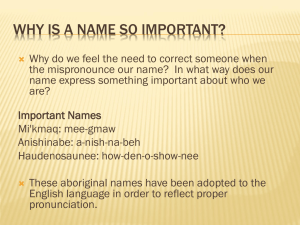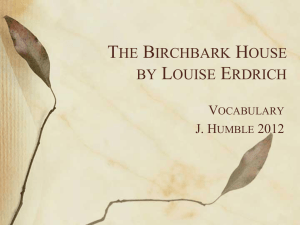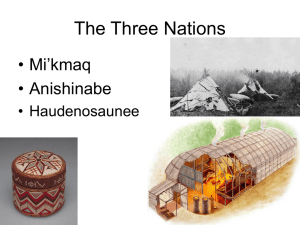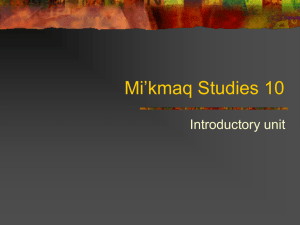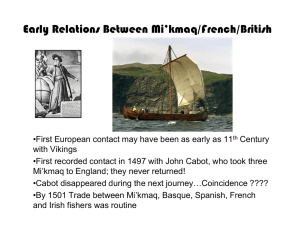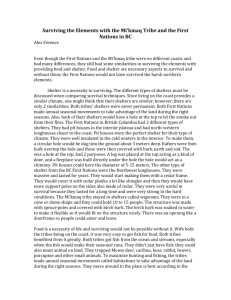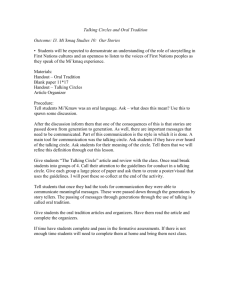Aboriginal History in Nova Scotia
advertisement
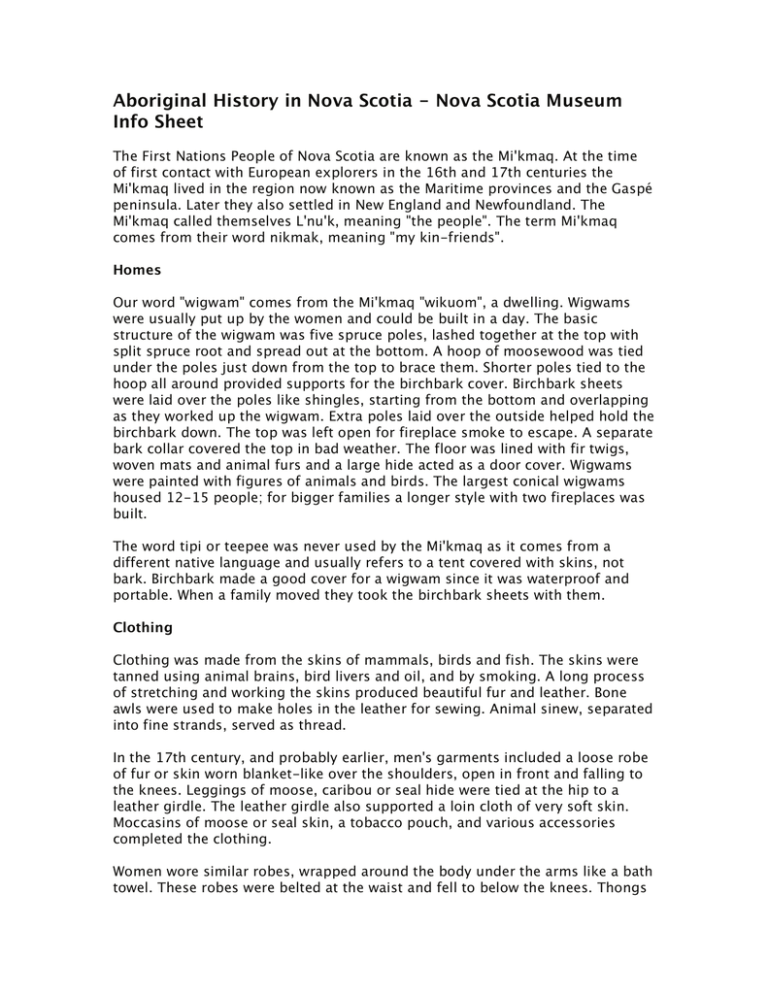
Aboriginal History in Nova Scotia - Nova Scotia Museum Info Sheet The First Nations People of Nova Scotia are known as the Mi'kmaq. At the time of first contact with European explorers in the 16th and 17th centuries the Mi'kmaq lived in the region now known as the Maritime provinces and the Gaspé peninsula. Later they also settled in New England and Newfoundland. The Mi'kmaq called themselves L'nu'k, meaning "the people". The term Mi'kmaq comes from their word nikmak, meaning "my kin-friends". Homes Our word "wigwam" comes from the Mi'kmaq "wikuom", a dwelling. Wigwams were usually put up by the women and could be built in a day. The basic structure of the wigwam was five spruce poles, lashed together at the top with split spruce root and spread out at the bottom. A hoop of moosewood was tied under the poles just down from the top to brace them. Shorter poles tied to the hoop all around provided supports for the birchbark cover. Birchbark sheets were laid over the poles like shingles, starting from the bottom and overlapping as they worked up the wigwam. Extra poles laid over the outside helped hold the birchbark down. The top was left open for fireplace smoke to escape. A separate bark collar covered the top in bad weather. The floor was lined with fir twigs, woven mats and animal furs and a large hide acted as a door cover. Wigwams were painted with figures of animals and birds. The largest conical wigwams housed 12-15 people; for bigger families a longer style with two fireplaces was built. The word tipi or teepee was never used by the Mi'kmaq as it comes from a different native language and usually refers to a tent covered with skins, not bark. Birchbark made a good cover for a wigwam since it was waterproof and portable. When a family moved they took the birchbark sheets with them. Clothing Clothing was made from the skins of mammals, birds and fish. The skins were tanned using animal brains, bird livers and oil, and by smoking. A long process of stretching and working the skins produced beautiful fur and leather. Bone awls were used to make holes in the leather for sewing. Animal sinew, separated into fine strands, served as thread. In the 17th century, and probably earlier, men's garments included a loose robe of fur or skin worn blanket-like over the shoulders, open in front and falling to the knees. Leggings of moose, caribou or seal hide were tied at the hip to a leather girdle. The leather girdle also supported a loin cloth of very soft skin. Moccasins of moose or seal skin, a tobacco pouch, and various accessories completed the clothing. Women wore similar robes, wrapped around the body under the arms like a bath towel. These robes were belted at the waist and fell to below the knees. Thongs over the shoulders acted as suspenders. Both sexes often wore a pair of sleeves of fur or leather, resembling two halves of a bolero jacket cut down the middle and tied together at center back and front. Women also wore leggings and moccasins and carried tobacco pouches. Children wore a smaller version of the adult costume. Babies were wrapped in the softest skins of fox, swan or goose. Mi'kmaq clothing was decorated with geometric patterns and designs of birds, beasts and humans. Pigments used for painting were red and yellow ochre from the earth, charcoal and ground white shell. These were mixed with fish roe or bird egg yolks. Animal fat was mixed with pigments to paint the body. Animal teeth, claws, bone and quills were sewn onto clothing, and feathers were sometimes used as ornaments. Men might wear a bird wing on either side of the head. Dyes for decorating quills came from roots, bark, leaves and flowers. When Europeans came to North America the Mi'kmaq traded with them, receiving cloth, ribbons and beads in exchange for furs and meat. They found new ways to use quills and moose hair on cloth, and worked ribbon and beads into traditional designs. By the 19th century the woman's costume included a beaded peaked cap and a woolen skirt. The man's coat reflected European military uniforms. Gear Before the arrival of Europeans the Mi'kmaq people had mastered techniques which enabled them to make tools and equipment from animal bone, ivory, teeth, claws, hair, feathers, fur, leather, quills, shells, clay, native copper, stone, wood, roots and bark. Axes, adzes and gouges were made by pecking and grinding stone to a sharp edge and smooth surface. In turn, these tools were used to cut and carve wood. Fine carving was done with sharp beaver teeth. For killing game and butchering meat, they used spears, knives, arrow points and scrapers, all made from special stones like chalcedony. This rock fractures in a way which "peels" the stone away in flakes, creating a razor-sharp edge. Bone points were used to harpoon sturgeon and porpoise, and for the woodand-bone fish spears. Awls, painting tools and sewing needles were also of bone. Copper was worked into needles and fishhooks. This type of equipment was usually made by men, who also fashioned baby-carriers, sleds, snowshoe frames and tobacco pipes of stone, bone, bark, wood and even lobster claws. In addition to preparing clothing, women made bags and mats of reeds, of cedar and basswood bark, of grasses and cattail leaves. The variety of weaves and dye-colours they used impressed early European settlers. Women may also have made baskets of long tree shoots or plant stems, using a wicker weave. Weirs were made in this way to trap fish, driving stakes into the stream bed and weaving branches in and out until the river was blocked and the eels or fish were forced to swim into a trap. After 1600 Mi'kmaq women began making a variety of items solely for sale to Europeans. This included their famous porcupine quillwork on bark, where hundreds of brightly-dyed quills were used to make a mosaic on top of birchbark. The quill ends were inserted into holes in wet bark, which quickly contracted around them to hold the quills in place. Bark ornamented like this was then made into boxes, chair upholstery, and many other "European" items. The women also sold settlers an enormous variety of baskets, now being made of wood splints. Dyes and decorative weaves made these as pretty as the older reed bags. Bead-work items were for sale, too, and examples of lavishly beaded and appliquéd tea cosies, purses and men's vests still survive in museums. Transportation The wide-bottomed Mi'kmaq canoe was raised at both ends and the sides curved upwards in the middle. This shape allowed the Mi'kmaq to canoe far out to sea as well as in shallow streams and even in rapids. Canoes were 3m to 8m long, made of birchbark over a light wooden frame. A small canoe could take a load of several hundred pounds but was light enough for one person to carry. Snowshoes are a native invention. The Mi'kmaq created different shapes and weaves for various snow conditions. They also made sleds to carry heavy loads over snow; they called the sled a toboggan. Food The Mi'kmaq spent most of the year along the sea coast, taking advantage of the wealth of food available there throughout all but about six weeks of the year. Fish of all kinds, including salmon and sturgeon, plus porpoises, whales, walrus, seals, lobster, squid, shellfish, eels and seabirds with their eggs made up the bulk of their diet. They also ate moose, caribou, beaver and porcupine, as well as smaller animals, like squirrels. Berries, roots and edible plants were gathered during the summer. Meat and fish were dried and smoked to preserve them. Pastimes The Mi'kmaq entertained each other with storytelling. Stories often lasted several days, and included singing, dancing and feasting. Everyone smoked: their tobacco was made from red willow bark, bearberry leaves and a native tobacco plant. The dice game Waltes was a favourite game, and is still played today. There were contests of running, wrestling and shooting, plus various ball games. Language The Mi'kmaq language, one of the Algonkian family of languages, is rich and descriptive. Their name for the month of May is Tqoljewiku's, "frog croaking moon". February is Apiknajit, the "snow-blinder". Some place names Shubenacadie, Whycocomagh, Malagash, Pugwash, Merigomish, Musquodoboit come from the Mi'kmaq. The language is still spoken today.
